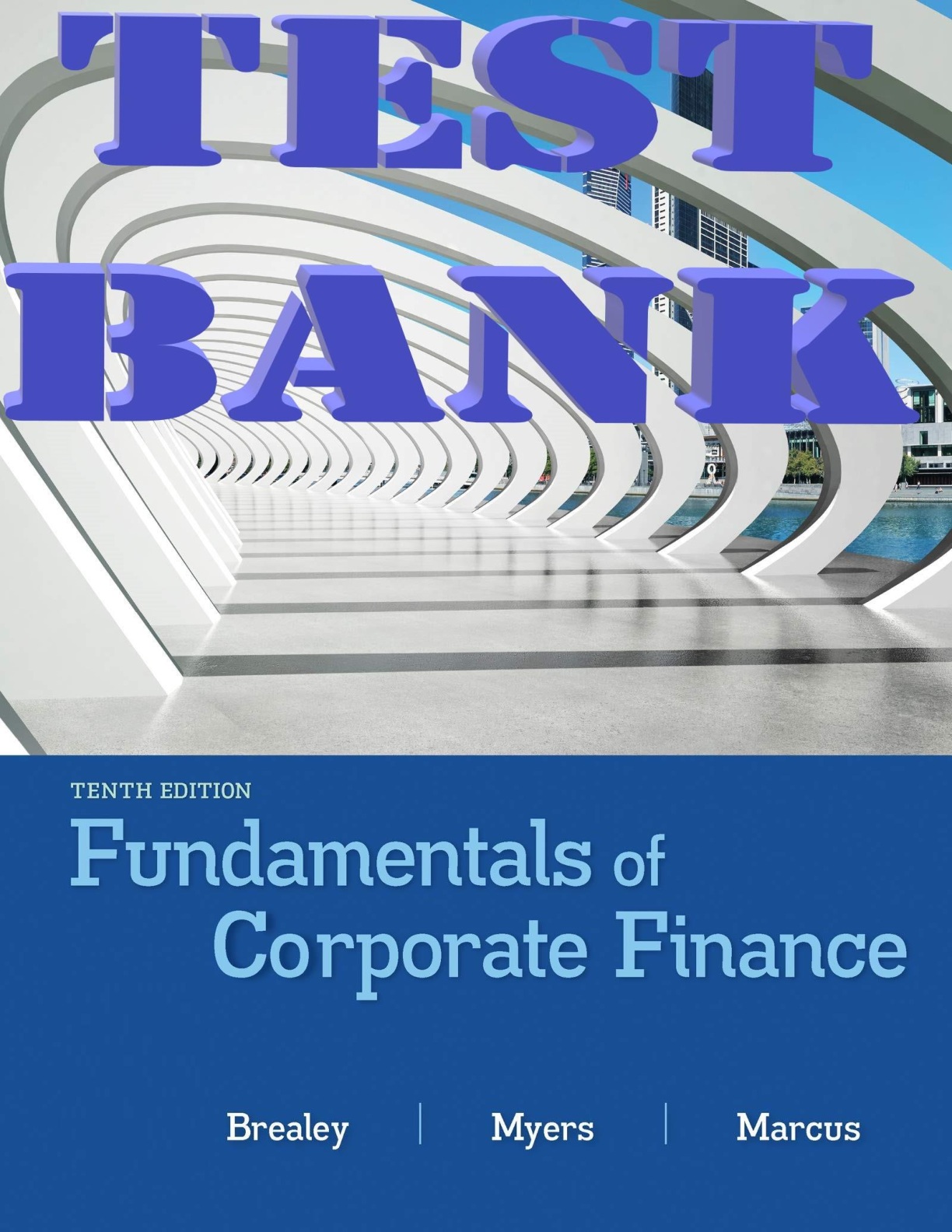Corporate Finance The Core, 5E by Berk Test Bank
Document Content and Description Below
Test Bank for Corporate Finance The Core, 5E, 5th Edition by Jonathan Berk,Peter DeMarzo TEST BANK ISBN-13: 9780135161159 Full chapters included Part 1 Introduction Chapter 1 The Corporation and... Financial Markets 1.1 The Four Types of Firms Sole Proprietorships Partnerships Limited Liability Companies Corporations Formation of a Corporation Ownership of a Corporation Tax Implications for Corporate Entities S Corporations 1.2 Ownership Versus Control of Corporations The Corporate Management Team The Financial Manager Investment Decisions Financing Decisions Cash Management The Goal of the Firm The Firm and Society Ethics and Incentives within Corporations Agency Problems The CEO’s Performance Corporate Bankruptcy 1.3 The Stock Market Primary and Secondary Stock Markets Traditional Trading Venues New Competition and Market Changes Dark Pools 1.4 Fintech: Finance and Technology Telecommunications Security and Verification Automation of Banking Services Big Data and Machine Learning Competition Key Terms Further Reading Problems The Four Types of Firms Ownership Versus Control of Corporations The Stock Market Fintech: Finance and Technology Chapter 2 Introduction to Financial Statement Analysis 2.1 Firms’ Disclosure of Financial Information Preparation of Financial Statements Types of Financial Statements 2.2 The Balance Sheet Assets Current Assets Long-Term Assets Liabilities Current Liabilities Long-Term Liabilities Stockholders’ Equity Market Value Versus Book Value Market-to-Book Ratio Enterprise Value 2.3 The Income Statement Earnings Calculations Gross Profit Operating Expenses Earnings before Interest and Taxes Pretax and Net Income 2.4 The Statement of Cash Flows Operating Activity Investment Activity Financing Activity 2.5 Other Financial Statement Information Statement of Stockholders’ Equity Management Discussion and Analysis Notes to the Financial Statements 2.6 Financial Statement Analysis Profitability Ratios Liquidity Ratios Working Capital Ratios Interest Coverage Ratios Leverage Ratios Valuation Ratios Operating Returns The DuPont Identity 2.7 Financial Reporting in Practice Enron WorldCom Sarbanes-Oxley Act Dodd-Frank Act Key Terms Further Reading Problems Firms’ Disclosure of Financial Information The Balance Sheet The Income Statement The Statement of Cash Flows Other Financial Statement Information Financial Statement Analysis Financial Reporting in Practice Data Case Chapter 3 Financial Decision Making and the Law of One Price Notation 3.1 Valuing Decisions Analyzing Costs and Benefits Using Market Prices to Determine Cash Values 3.2 Interest Rates and the Time Value of Money The Time Value of Money The Interest Rate: An Exchange Rate Across Time Value of Investment in One Year Value of Investment Today Present Versus Future Value Discount Factors and Rates 3.3 Present Value and the NPV Decision Rule Net Present Value The NPV Decision Rule Accepting or Rejecting a Project Choosing among Alternatives NPV and Cash Needs 3.4 Arbitrage and the Law of One Price Arbitrage Law of One Price 3.5 No-Arbitrage and Security Prices Valuing a Security with the Law of One Price Identifying Arbitrage Opportunities with Securities Determining the No-Arbitrage Price Determining the Interest Rate from Bond Prices The NPV of Trading Securities and Firm Decision Making Valuing a Portfolio Value Additivity Value Additivity and Firm Value Where Do We Go from Here? Key Terms Further Reading Problems Valuing Decisions Interest Rates and the Time Value of Money Present Value and the NPV Decision Rule Arbitrage and the Law of One Price No-Arbitrage and Security Prices Data Case Arbitraging Bitcoin Chapter 3 Appendix The Price of Risk Notation Risky Versus Risk-Free Cash Flows Risk Aversion and the Risk Premium The No-Arbitrage Price of a Risky Security Risk Premiums Depend on Risk Risk Is Relative to the Overall Market Risk, Return, and Market Prices Arbitrage with Transactions Costs Key Terms Problems Risky Versus Risk-Free Cash Flows Arbitrage with Transactions Costs Part 2 Time, Money, and Interest Rates Chapter 4 The Time Value of Money Notation 4.1 The Timeline 4.2 The Three Rules of Time Travel Rule 1: Comparing and Combining Values Rule 2: Moving Cash Flows Forward in Time Rule 3: Moving Cash Flows Back in Time Applying the Rules of Time Travel 4.3 Valuing a Stream of Cash Flows 4.4 Calculating the Net Present Value 4.5 Perpetuities and Annuities Perpetuities Annuities Present Value of an Annuity Future Value of an Annuity Growing Cash Flows Growing Perpetuity Growing Annuity 4.6 Using an Annuity Spreadsheet or Calculator 4.7 Non-Annual Cash Flows 4.8 Solving for the Cash Payments 4.9 The Internal Rate of Return Key Terms Further Reading Problems The Timeline The Three Rules of Time Travel Valuing a Stream of Cash Flows Calculating the Net Present Value Perpetuities and Annuities Non-Annual Cash Flows Solving for the Cash Payments The Internal Rate of Return Data Case Chapter 4 Appendix Solving for the Number of Periods Problems Chapter 5 Interest Rates Notation 5.1 Interest Rate Quotes and Adjustments The Effective Annual Rate Adjusting the Discount Rate to Different Time Periods General Equation for Discount Rate Period Conversion Annual Percentage Rates 5.2 Application: Discount Rates and Loans 5.3 The Determinants of Interest Rates Inflation and Real Versus Nominal Rates Investment and Interest Rate Policy Monetary Policy, Deflation, and the 2008 Financial Crisis The Yield Curve and Discount Rates The Yield Curve and the Economy Interest Rate Determination Interest Rate Expectations 5.4 Risk and Taxes Risk and Interest Rates After-Tax Interest Rates 5.5 The Opportunity Cost of Capital Key Terms Further Reading Problems Interest Rate Quotes and Adjustments Application: Discount Rates and Loans The Determinants of Interest Rates Risk and Taxes The Opportunity Cost of Capital Data Case Florida’s Pension Plan Liability Chapter 5 Appendix Continuous Rates and Cash Flows Notation Discount Rates for a Continuously Compounded APR Continuously Arriving Cash Flows Chapter 6 Valuing Bonds Notation 6.1 Bond Cash Flows, Prices, and Yields Bond Terminology Zero-Coupon Bonds Yield to Maturity Risk-Free Interest Rates Coupon Bonds 6.2 Dynamic Behavior of Bond Prices Discounts and Premiums Time and Bond Prices Interest Rate Changes and Bond Prices 6.3 The Yield Curve and Bond Arbitrage Replicating a Coupon Bond Valuing a Coupon Bond Using Zero-Coupon Yields Coupon Bond Yields Treasury Yield Curves 6.4 Corporate Bonds Corporate Bond Yields No Default Certain Default Risk of Default Bond Ratings Corporate Yield Curves 6.5 Sovereign Bonds Key Terms Further Reading Problems Bond Cash Flows, Prices, and Yields Dynamic Behavior of Bond Prices The Yield Curve and Bond Arbitrage Corporate Bonds Sovereign Bonds Data Case Corporate Yield Curves Case Study The 2012 Greek Default and Subsequent Debt Restructuring6 Chapter 6 Appendix Forward Interest Rates Notation Computing Forward Rates Computing Bond Yields from Forward Rates Forward Rates and Future Interest Rates Key Terms Problems Part 3 Valuing Projects and Firms Chapter 7 Investment Decision Rules Notation 7.1 NPV and Stand-Alone Projects Applying the NPV Rule The NPV Profile and IRR Alternative Rules Versus the NPV Rule 7.2 The Internal Rate of Return Rule Applying the IRR Rule Pitfall #1: Delayed Investments Pitfall #2: Multiple IRRs Pitfall #3: Nonexistent IRR 7.3 The Payback Rule Applying the Payback Rule Payback Rule Pitfalls in Practice 7.4 Choosing between Projects NPV Rule and Mutually Exclusive Investments IRR Rule and Mutually Exclusive Investments Differences in Scale Differences in Timing Differences in Risk The Incremental IRR 7.5 Project Selection with Resource Constraints Evaluating Projects with Different Resource Requirements Profitability Index Shortcomings of the Profitability Index Key Terms Further Reading Problems NPV and Stand-Alone Projects The Internal Rate of Return Rule The Payback Rule Choosing between Projects Project Selection with Resource Constraints Data Case Chapter 7 Appendix Computing the NPV Profile Using Excel’s Data Table Function Chapter 8 Fundamentals of Capital Budgeting Notation 8.1 Forecasting Earnings Revenue and Cost Estimates Incremental Earnings Forecast Capital Expenditures and Depreciation Interest Expenses Taxes Unlevered Net Income Calculation Indirect Effects on Incremental Earnings Opportunity Costs Project Externalities Sunk Costs and Incremental Earnings Fixed Overhead Expenses Past Research and Development Expenditures Unavoidable Competitive Effects Real-World Complexities 8.2 Determining Free Cash Flow and NPV Calculating Free Cash Flow from Earnings Capital Expenditures and Depreciation Net Working Capital (NWC) Calculating Free Cash Flow Directly Calculating the NPV 8.3 Choosing among Alternatives Evaluating Manufacturing Alternatives Comparing Free Cash Flows for Cisco’s Alternatives 8.4 Further Adjustments to Free Cash Flow 8.5 Analyzing the Project Break-Even Analysis Sensitivity Analysis Scenario Analysis Key Terms Further Reading Problems Forecasting Earnings Determining Free Cash Flow and NPV Choosing among Alternatives Further Adjustments to Free Cash Flow Analyzing the Project Data Case Chapter 8 Appendix MACRS Depreciation Chapter 9 Valuing Stocks Notation 9.1 The Dividend-Discount Model A One-Year Investor Dividend Yields, Capital Gains, and Total Returns A Multiyear Investor The Dividend-Discount Model Equation 9.2 Applying the Dividend-Discount Model Constant Dividend Growth Dividends Versus Investment and Growth A Simple Model of Growth Profitable Growth Changing Growth Rates Limitations of the Dividend-Discount Model 9.3 Total Payout and Free Cash Flow Valuation Models Share Repurchases and the Total Payout Model The Discounted Free Cash Flow Model Valuing the Enterprise Implementing the Model Connection to Capital Budgeting 9.4 Valuation Based on Comparable Firms Valuation Multiples The Price-Earnings Ratio Enterprise Value Multiples Other Multiples Limitations of Multiples Comparison with Discounted Cash Flow Methods Stock Valuation Techniques: The Final Word 9.5 Information, Competition, and Stock Prices Information in Stock Prices Competition and Efficient Markets Public, Easily Interpretable Information Private or Difficult-to-Interpret Information Lessons for Investors and Corporate Managers Consequences for Investors Implications for Corporate Managers The Efficient Markets Hypothesis Versus No Arbitrage Key Terms Further Reading Problems The Dividend-Discount Model Applying the Dividend-Discount Model Total Payout and Free Cash Flow Valuation Models Valuation Based on Comparable Firms Information, Competition, and Stock Prices Data Case Part 4 Risk and Return Chapter 10 Capital Markets and the Pricing of Risk Notation 10.1 Risk and Return: Insights from 92 Years of Investor History 10.2 Common Measures of Risk and Return Probability Distributions Expected Return Variance and Standard Deviation 10.3 Historical Returns of Stocks and Bonds Computing Historical Returns Calculating Realized Annual Returns Comparing Realized Annual Returns Average Annual Returns The Variance and Volatility of Returns Estimation Error: Using Past Returns to Predict the Future Standard Error Limitations of Expected Return Estimates 10.4 The Historical Tradeoff Between Risk and Return The Returns of Large Portfolios The Returns of Individual Stocks 10.5 Common Versus Independent Risk Theft Versus Earthquake Insurance: An Example Types of Risk The Role of Diversification 10.6 Diversification in Stock Portfolios Firm-Specific Versus Systematic Risk No Arbitrage and the Risk Premium 10.7 Measuring Systematic Risk Identifying Systematic Risk: The Market Portfolio Sensitivity to Systematic Risk: Beta Real-Firm Betas Interpreting Betas 10.8 Beta and the Cost of Capital Estimating the Risk Premium The Market Risk Premium Adjusting for Beta The Capital Asset Pricing Model Key Terms Further Reading Problems Common Measures of Risk and Return Historical Returns of Stocks and Bonds The Historical Tradeoff Between Risk and Return Common Versus Independent Risk Diversification in Stock Portfolios Measuring Systematic Risk Beta and the Cost of Capital Chapter 11 Optimal Portfolio Choice and the Capital Asset Pricing Model Notation 11.1 The Expected Return of a Portfolio 11.2 The Volatility of a Two-Stock Portfolio Combining Risks Determining Covariance and Correlation Covariance Correlation Computing a Portfolio’s Variance and Volatility 11.3 The Volatility of a Large Portfolio Large Portfolio Variance Diversification with an Equally Weighted Portfolio Diversification with General Portfolios 11.4 Risk Versus Return: Choosing an Efficient Portfolio Efficient Portfolios with Two Stocks Identifying Inefficient Portfolios Identifying Efficient Portfolios The Effect of Correlation Short Sales Efficient Portfolios with Many Stocks 11.5 Risk-Free Saving and Borrowing Investing in Risk-Free Securities Borrowing and Buying Stocks on Margin Identifying the Tangent Portfolio 11.6 The Efficient Portfolio and Required Returns Portfolio Improvement: Beta and the Required Return Expected Returns and the Efficient Portfolio 11.7 The Capital Asset Pricing Model The CAPM Assumptions Supply, Demand, and the Efficiency of the Market Portfolio Optimal Investing: The Capital Market Line 11.8 Determining the Risk Premium Market Risk and Beta The Security Market Line Beta of a Portfolio Summary of the Capital Asset Pricing Model Key Terms Further Reading Problems The Expected Return of a Portfolio The Volatility of a Two-Stock Portfolio The Volatility of a Large Portfolio Risk Versus Return: Choosing an Efficient Portfolio Risk-Free Saving and Borrowing The Efficient Portfolio and Required Returns The Capital Asset Pricing Model Determining the Risk Premium Data Case Chapter 11 Appendix The CAPM with Differing Interest Rates The Efficient Frontier with Differing Saving and Borrowing Rates The Security Market Line with Differing Interest Rates Chapter 12 Estimating the Cost of Capital Notation 12.1 The Equity Cost of Capital 12.2 The Market Portfolio Constructing the Market Portfolio Market Indexes Examples of Market Indexes Investing in a Market Index The Market Risk Premium Determining the Risk-Free Rate The Historical Risk Premium A Fundamental Approach 12.3 Beta Estimation Using Historical Returns Identifying the Best-Fitting Line Using Linear Regression 12.4 The Debt Cost of Capital Debt Yields Versus Returns Debt Betas 12.5 A Project’s Cost of Capital All-Equity Comparables Levered Firms as Comparables The Unlevered Cost of Capital Unlevered Beta Cash and Net Debt Industry Asset Betas 12.6 Project Risk Characteristics and Financing Differences in Project Risk Financing and the Weighted Average Cost of Capital Perfect Capital Markets Taxes—A Big Imperfection The Weighted Average Cost of Capital 12.7 Final Thoughts on Using the CAPM Key Terms Further Reading Problems The Equity Cost of Capital The Market Portfolio Beta Estimation The Debt Cost of Capital A Project’s Cost of Capital Project Risk Characteristics and Financing Data Case Chapter 12 Appendix Practical Considerations When Forecasting Beta Time Horizon The Market Proxy Beta Variation and Extrapolation Outliers Other Considerations Key Terms Data Case Chapter 13 Investor Behavior and Capital Market Efficiency Notation 13.1 Competition and Capital Markets Identifying a Stock’s Alpha Profiting from Non-Zero Alpha Stocks 13.2 Information and Rational Expectations Informed Versus Uninformed Investors Rational Expectations 13.3 The Behavior of Individual Investors Underdiversification and Portfolio Biases Excessive Trading and Overconfidence Individual Behavior and Market Prices 13.4 Systematic Trading Biases Hanging on to Losers and the Disposition Effect Investor Attention, Mood, and Experience Herd Behavior Implications of Behavioral Biases 13.5 The Efficiency of the Market Portfolio Trading on News or Recommendations Takeover Offers Stock Recommendations The Performance of Fund Managers Fund Manager Value-Added Returns to Investors The Winners and Losers 13.6 Style-Based Techniques and the Market Efficiency Debate Size Effects Excess Return and Market Capitalizations Excess Return and Book-to-Market Ratio Size Effects and Empirical Evidence Momentum Implications of Positive-Alpha Trading Strategies Proxy Error Behavioral Biases Alternative Risk Preferences and Non-Tradable Wealth 13.7 Multifactor Models of Risk Using Factor Portfolios Smart Beta Long-Short Portfolios Selecting the Portfolios Market Capitalization Strategy Book-to-Market Ratio Strategy Past Returns Strategy Fama-French-Carhart Factor Specification The Cost of Capital with Fama-French-Carhart Factor Specification 13.8 Methods Used in Practice Financial Managers Investors Key Terms Further Reading Problems Competition and Capital Markets Information and Rational Expectations The Behavior of Individual Investors Systematic Trading Biases The Efficiency of the Market Portfolio Style-Based Techniques and the Market Efficiency Debate Multifactor Models of Risk Chapter 13 Appendix Building a Multifactor Model Part 5 Capital Structure Chapter 14 Capital Structure in a Perfect Market Notation 14.1 Equity Versus Debt Financing Financing a Firm with Equity Financing a Firm with Debt and Equity The Effect of Leverage on Risk and Return 14.2 Modigliani-Miller I: Leverage, Arbitrage, and Firm Value MM and the Law of One Price Homemade Leverage The Market Value Balance Sheet Application: A Leveraged Recapitalization 14.3 Modigliani-Miller II: Leverage, Risk, and the Cost of Capital Leverage and the Equity Cost of Capital Capital Budgeting and the Weighted Average Cost of Capital Computing the WACC with Multiple Securities Levered and Unlevered Betas 14.4 Capital Structure Fallacies Leverage and Earnings per Share Equity Issuances and Dilution 14.5 MM: Beyond the Propositions Key Terms Further Reading Problems Equity Versus Debt Financing Modigliani-Miller I: Leverage, Arbitrage, and Firm Value Modigliani-Miller II: Leverage, Risk, and the Cost of Capital Capital Structure Fallacies Data Case Chapter 15 Debt and Taxes Notation 15.1 The Interest Tax Deduction 15.2 Valuing the Interest Tax Shield The Interest Tax Shield and Firm Value The Interest Tax Shield with Permanent Debt The Weighted Average Cost of Capital with Taxes The Interest Tax Shield with a Target Debt-Equity Ratio 15.3 Recapitalizing to Capture the Tax Shield The Tax Benefit The Share Repurchase No Arbitrage Pricing Analyzing the Recap: The Market Value Balance Sheet 15.4 Personal Taxes Including Personal Taxes in the Interest Tax Shield Determining the Actual Tax Advantage of Debt Valuing the Interest Tax Shield with Personal Taxes 15.5 Optimal Capital Structure with Taxes Do Firms Prefer Debt? Limits to the Tax Benefit of Debt Growth and Debt Other Tax Shields The Low Leverage Puzzle Key Terms Further Reading Problems The Interest Tax Deduction Valuing the Interest Tax Shield Personal Taxes Optimal Capital Structure with Taxes Data Case Chapter 16 Financial Distress, Managerial Incentives, and Information Notation 16.1 Default and Bankruptcy in a Perfect Market Armin Industries: Leverage and the Risk of Default Scenario 1: New Product Succeeds Scenario 2: New Product Fails Comparing the Two Scenarios Bankruptcy and Capital Structure 16.2 The Costs of Bankruptcy and Financial Distress The Bankruptcy Code Direct Costs of Bankruptcy Indirect Costs of Financial Distress Overall Impact of Indirect Costs 16.3 Financial Distress Costs and Firm Value Armin Industries: The Impact of Financial Distress Costs Who Pays for Financial Distress Costs? 16.4 Optimal Capital Structure: The Tradeoff Theory The Present Value of Financial Distress Costs Optimal Leverage 16.5 Exploiting Debt Holders: The Agency Costs of Leverage Excessive Risk-Taking and Asset Substitution Debt Overhang and Under-Investment Cashing Out Estimating the Debt Overhang Agency Costs and the Value of Leverage The Leverage Ratchet Effect Debt Maturity and Covenants 16.6 Motivating Managers: The Agency Benefits of Leverage Concentration of Ownership Reduction of Wasteful Investment Leverage and Commitment 16.7 Agency Costs and the Tradeoff Theory The Optimal Debt Level R&D-Intensive Firms Low-Growth, Mature Firms Debt Levels in Practice 16.8 Asymmetric Information and Capital Structure Leverage as a Credible Signal Issuing Equity and Adverse Selection Implications for Equity Issuance Implications for Capital Structure 16.9 Capital Structure: The Bottom Line Key Terms Further Reading Problems Default and Bankruptcy in a Perfect Market The Costs of Bankruptcy and Financial Distress Financial Distress Costs and Firm Value Optimal Capital Structure: The Tradeoff Theory Exploiting Debt Holders: The Agency Costs of Leverage Motivating Managers: The Agency Benefits of Leverage Agency Costs and the Tradeoff Theory Asymmetric Information and Capital Structure Chapter 17 Payout Policy Notation 17.1 Distributions to Shareholders Dividends Share Repurchases Open Market Repurchase Tender Offer Targeted Repurchase 17.2 Comparison of Dividends and Share Repurchases Alternative Policy 1: Pay Dividend with Excess Cash Alternative Policy 2: Share Repurchase (No Dividend) Genron’s Future Dividends Investor Preferences Alternative Policy 3: High Dividend (Equity Issue) Modigliani-Miller and Dividend Policy Irrelevance Dividend Policy with Perfect Capital Markets 17.3 The Tax Disadvantage of Dividends Taxes on Dividends and Capital Gains Optimal Dividend Policy with Taxes 17.4 Dividend Capture and Tax Clienteles The Effective Dividend Tax Rate Tax Differences Across Investors Clientele Effects 17.5 Payout Versus Retention of Cash Retaining Cash with Perfect Capital Markets Taxes and Cash Retention Adjusting for Investor Taxes Issuance and Distress Costs Agency Costs of Retaining Cash 17.6 Signaling with Payout Policy Dividend Smoothing Dividend Signaling Signaling and Share Repurchases 17.7 Stock Dividends, Splits, and Spin-Offs Stock Dividends and Splits Spin-Offs Key Terms Further Reading Problems Distributions to Shareholders Comparison of Dividends and Share Repurchases The Tax Disadvantage of Dividends Dividend Capture and Tax Clienteles Payout Versus Retention of Cash Signaling with Payout Policy Stock Dividends, Splits, and Spin-Offs Data Case Part 6 Advanced Valuation Chapter 18 Capital Budgeting and Valuation with Leverage Notation 18.1 Overview of Key Concepts 18.2 The Weighted Average Cost of Capital Method Using the WACC to Value a Project Summary of the WACC Method Implementing a Constant Debt-Equity Ratio 18.3 The Adjusted Present Value Method The Unlevered Value of the Project Valuing the Interest Tax Shield Summary of the APV Method 18.4 The Flow-to-Equity Method Calculating the Free Cash Flow to Equity Valuing Equity Cash Flows Summary of the Flow-to-Equity Method 18.5 Project-Based Costs of Capital Estimating the Unlevered Cost of Capital Project Leverage and the Equity Cost of Capital Determining the Incremental Leverage of a Project Cash Is Negative Debt A Fixed Equity Payout Policy Implies 100% Debt Financing Optimal Leverage Depends on Project and Firm Characteristics Safe Cash Flows Can Be 100% Debt Financed 18.6 APV with Other Leverage Policies Constant Interest Coverage Ratio Predetermined Debt Levels A Comparison of Methods 18.7 Other Effects of Financing Issuance and Other Financing Costs Security Mispricing Financial Distress and Agency Costs 18.8 Advanced Topics in Capital Budgeting Periodically Adjusted Debt Leverage and the Cost of Capital The WACC or FTE Method with Changing Leverage Personal Taxes Key Terms Further Reading Problems Overview of Key Concepts The Weighted Average Cost of Capital Method The Adjusted Present Value Method The Flow-to-Equity Method Project-Based Costs of Capital APV with Other Leverage Policies Other Effects of Financing Advanced Topics in Capital Budgeting Data Case Chapter 18 Appendix Foundations and Further Details Deriving the WACC Method The Levered and Unlevered Cost of Capital Target Leverage Ratio Predetermined Debt Schedule Risk of the Tax Shield with a Target Leverage Ratio Solving for Leverage and Value Simultaneously The Residual Income and Economic Value Added Valuation Methods Chapter 19 Valuation and Financial Modeling: A Case Study Notation 19.1 Valuation Using Comparables 19.2 The Business Plan Operational Improvements Capital Expenditures: A Needed Expansion Working Capital Management Capital Structure Changes: Levering Up 19.3 Building the Financial Model Forecasting Earnings Working Capital Requirements Forecasting Free Cash Flow The Balance Sheet and Statement of Cash Flows (Optional) 19.4 Estimating the Cost of Capital CAPM-Based Estimation Unlevering Beta Ideko’s Unlevered Cost of Capital 19.5 Valuing the Investment The Multiples Approach to Continuation Value The Discounted Cash Flow Approach to Continuation Value APV Valuation of Ideko’s Equity A Reality Check IRR and Cash Multiples 19.6 Sensitivity Analysis Key Terms Further Reading Problems Valuation Using Comparables The Business Plan Building the Financial Model Estimating the Cost of Capital Valuing the Investment [Show More]
Last updated: 11 months ago
Preview 1 out of 1007 pages
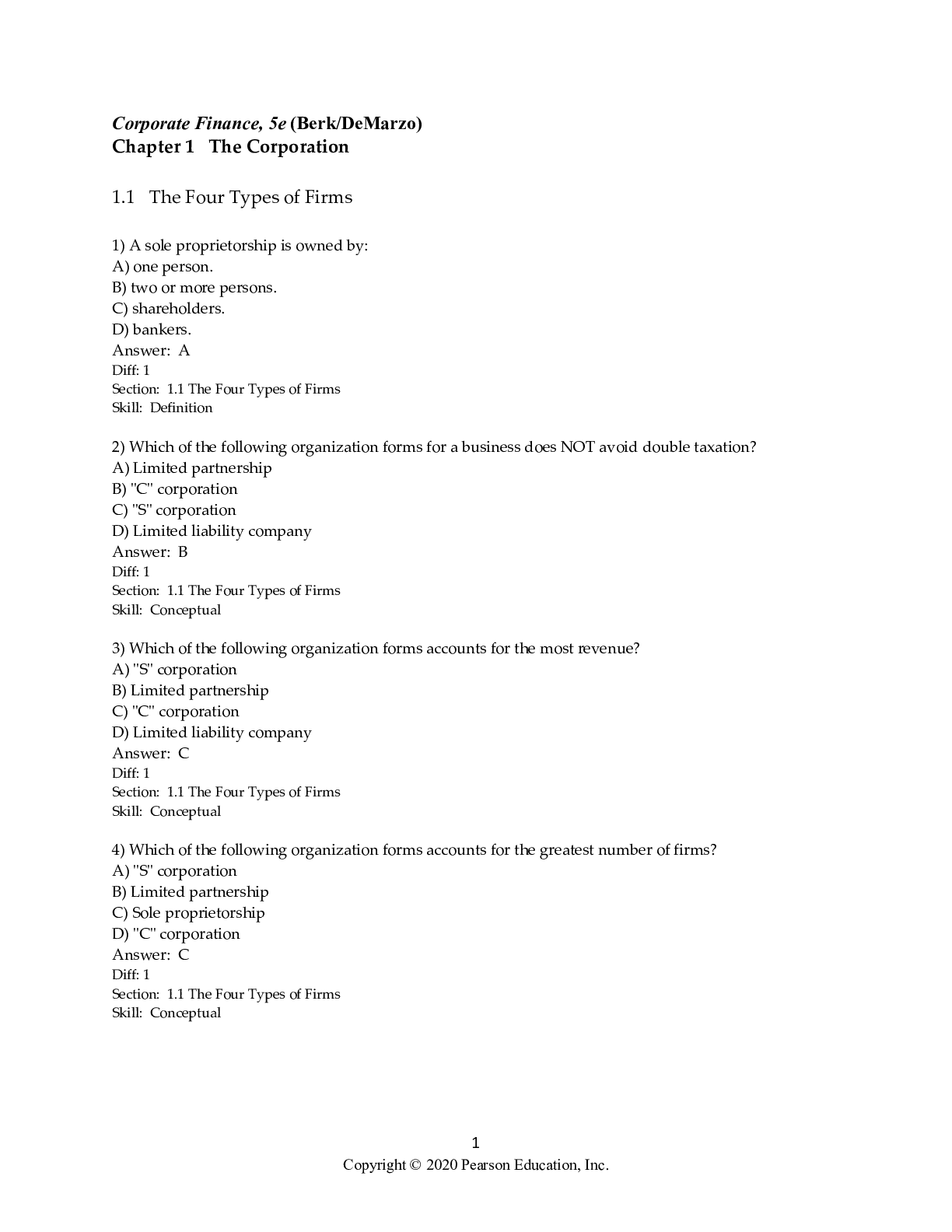
Reviews( 0 )
Document information
Connected school, study & course
About the document
Uploaded On
Sep 12, 2022
Number of pages
1007
Written in
Additional information
This document has been written for:
Uploaded
Sep 12, 2022
Downloads
0
Views
140

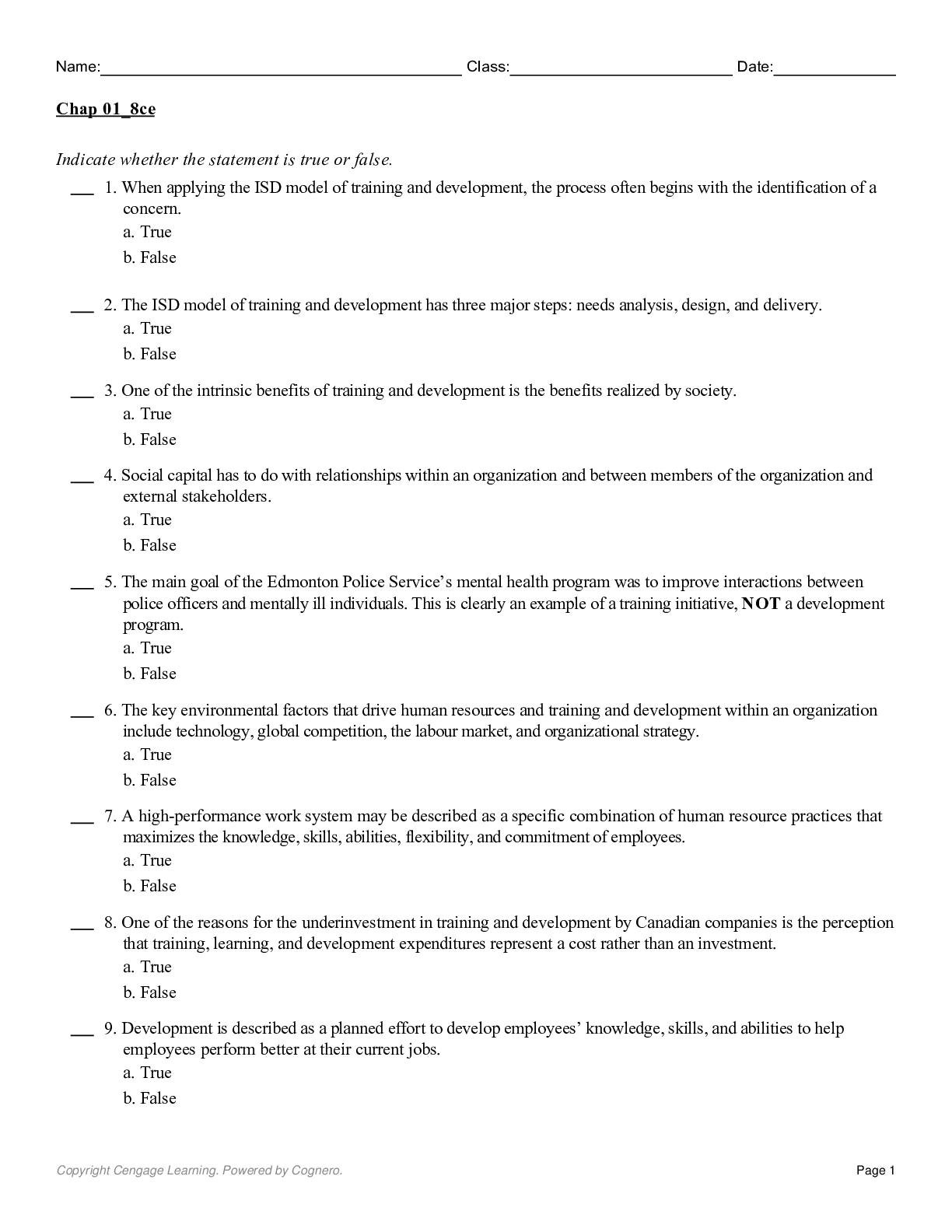
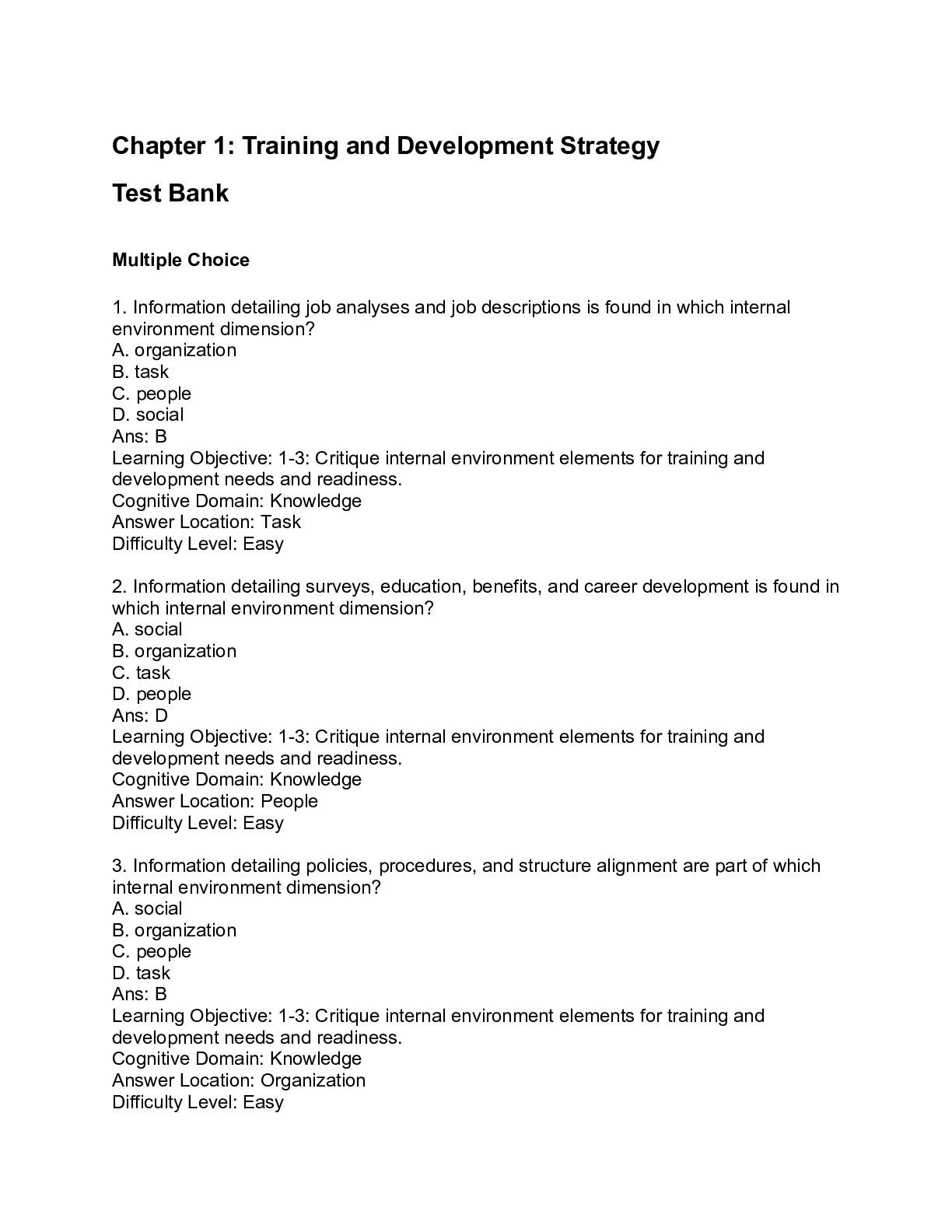
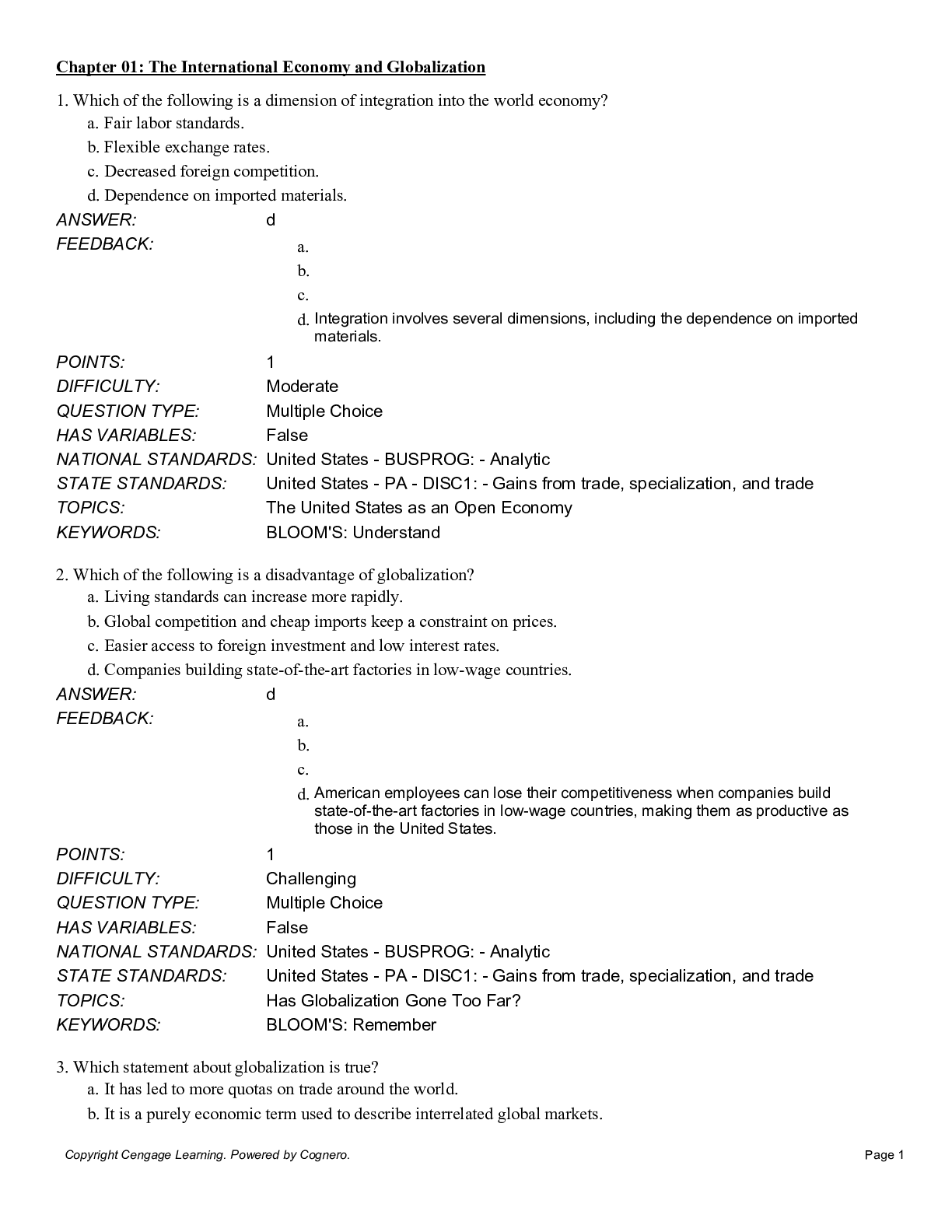
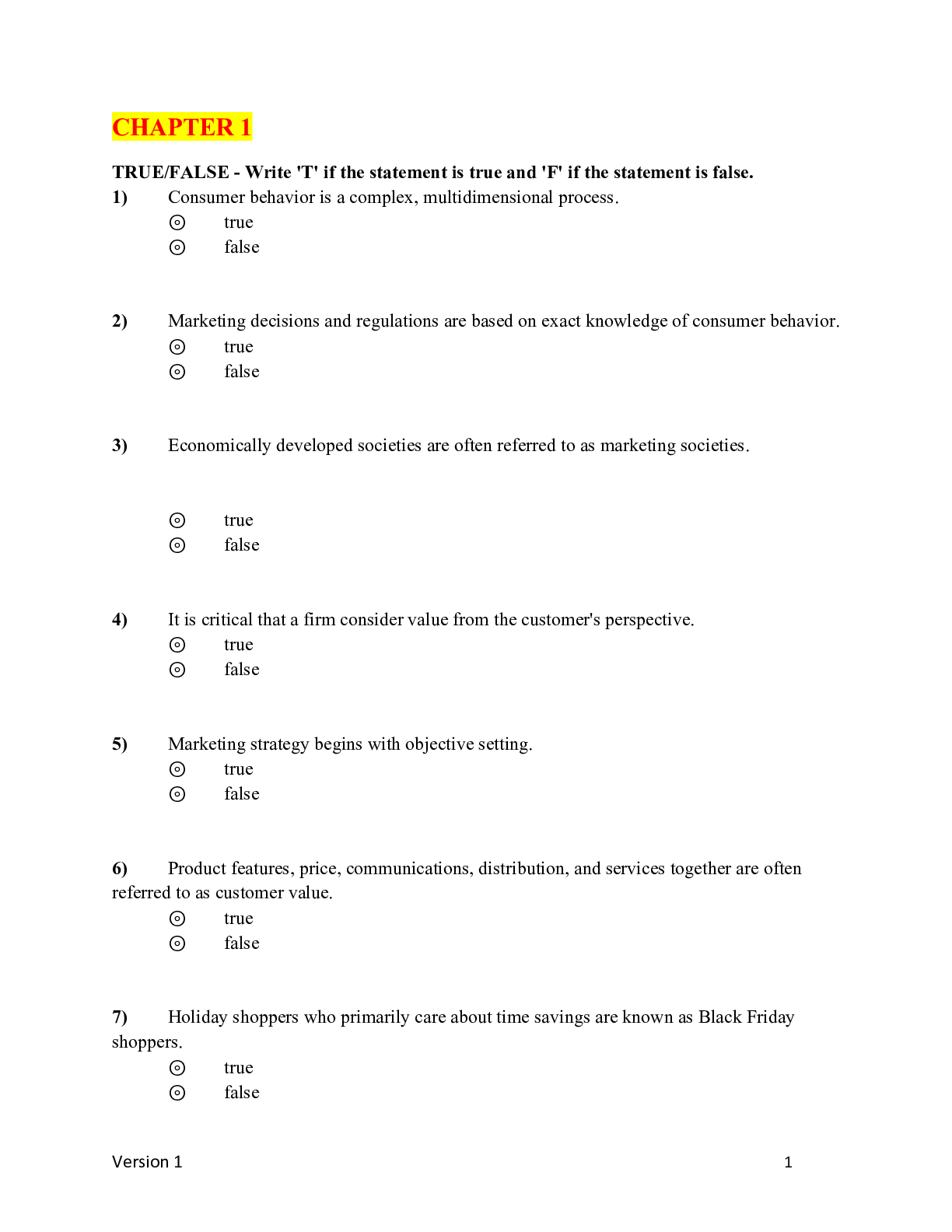
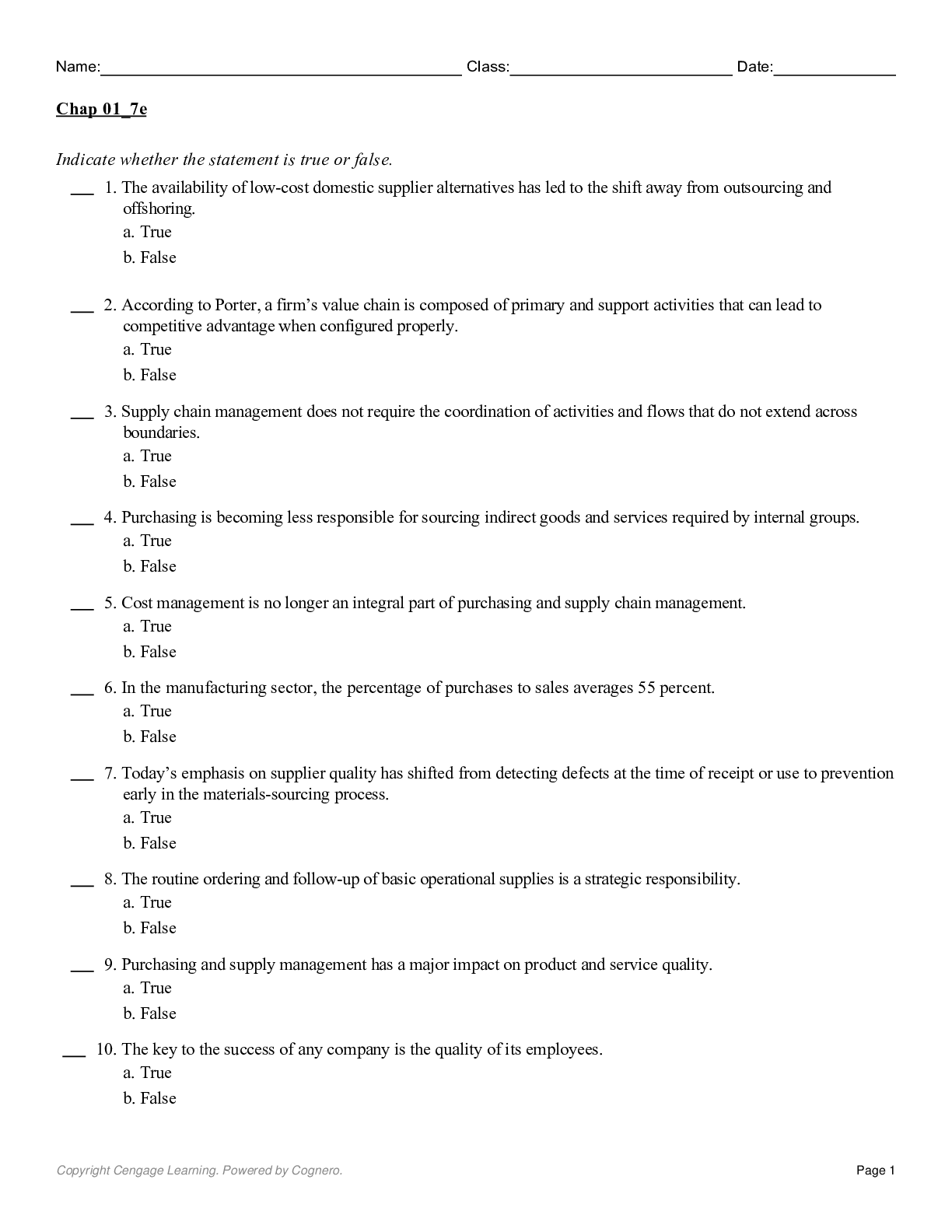
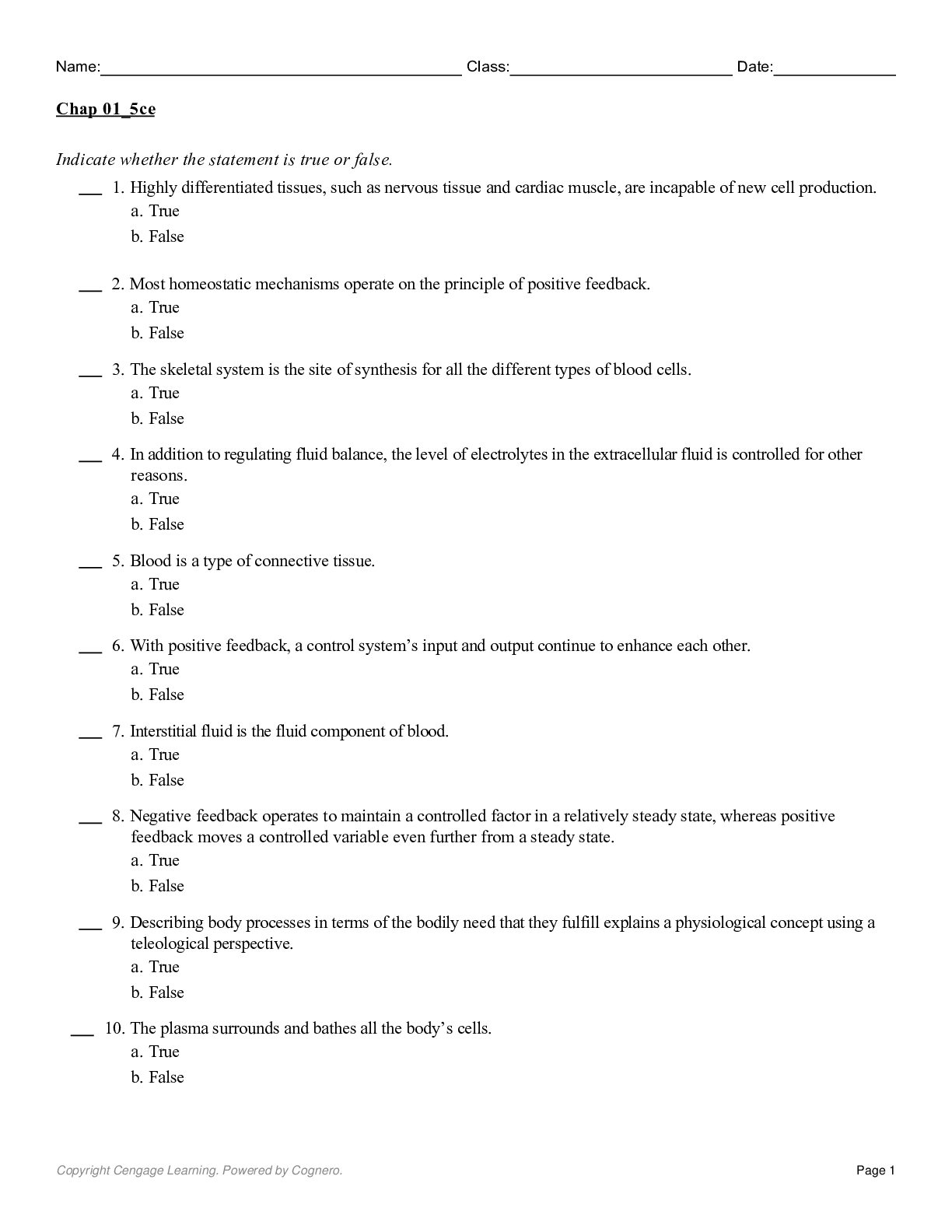

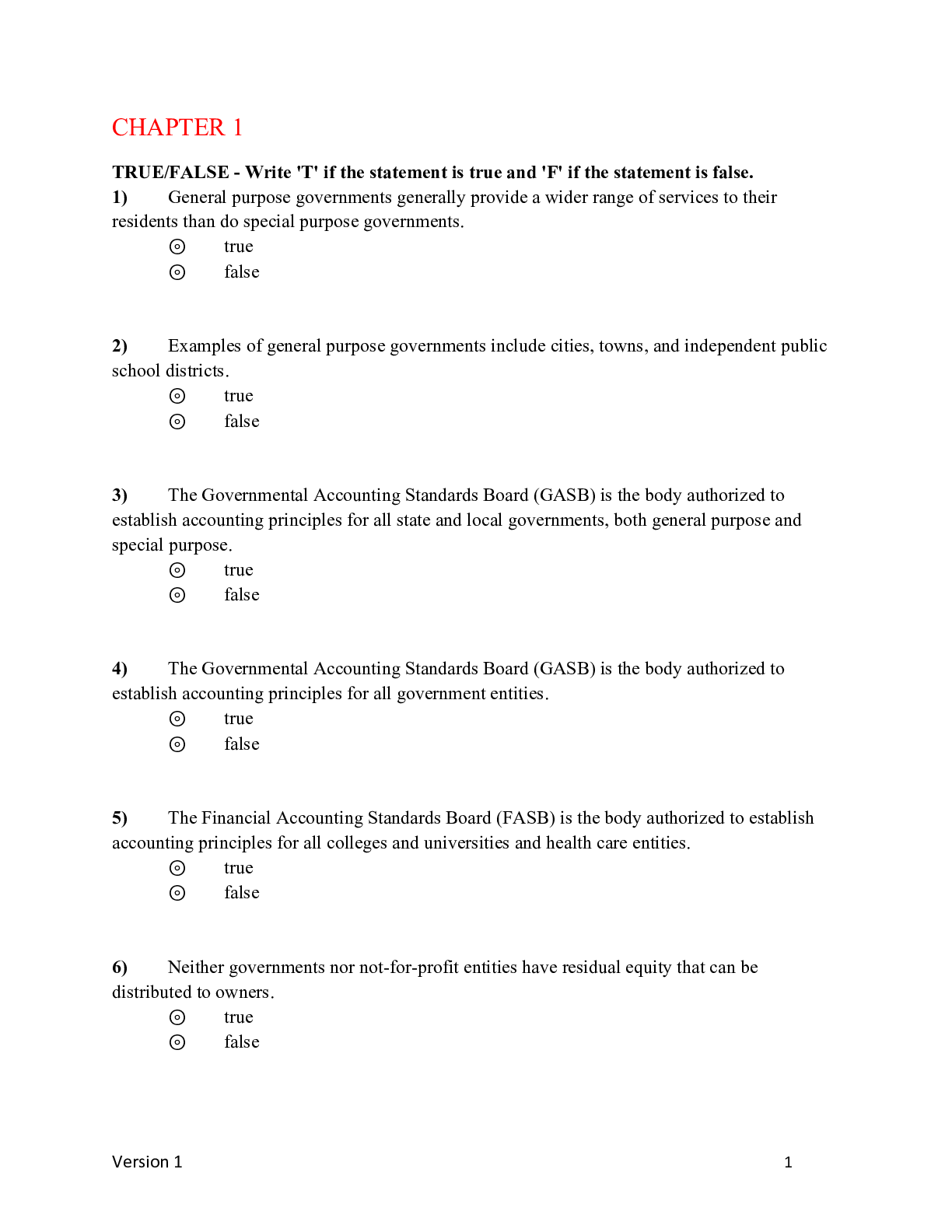
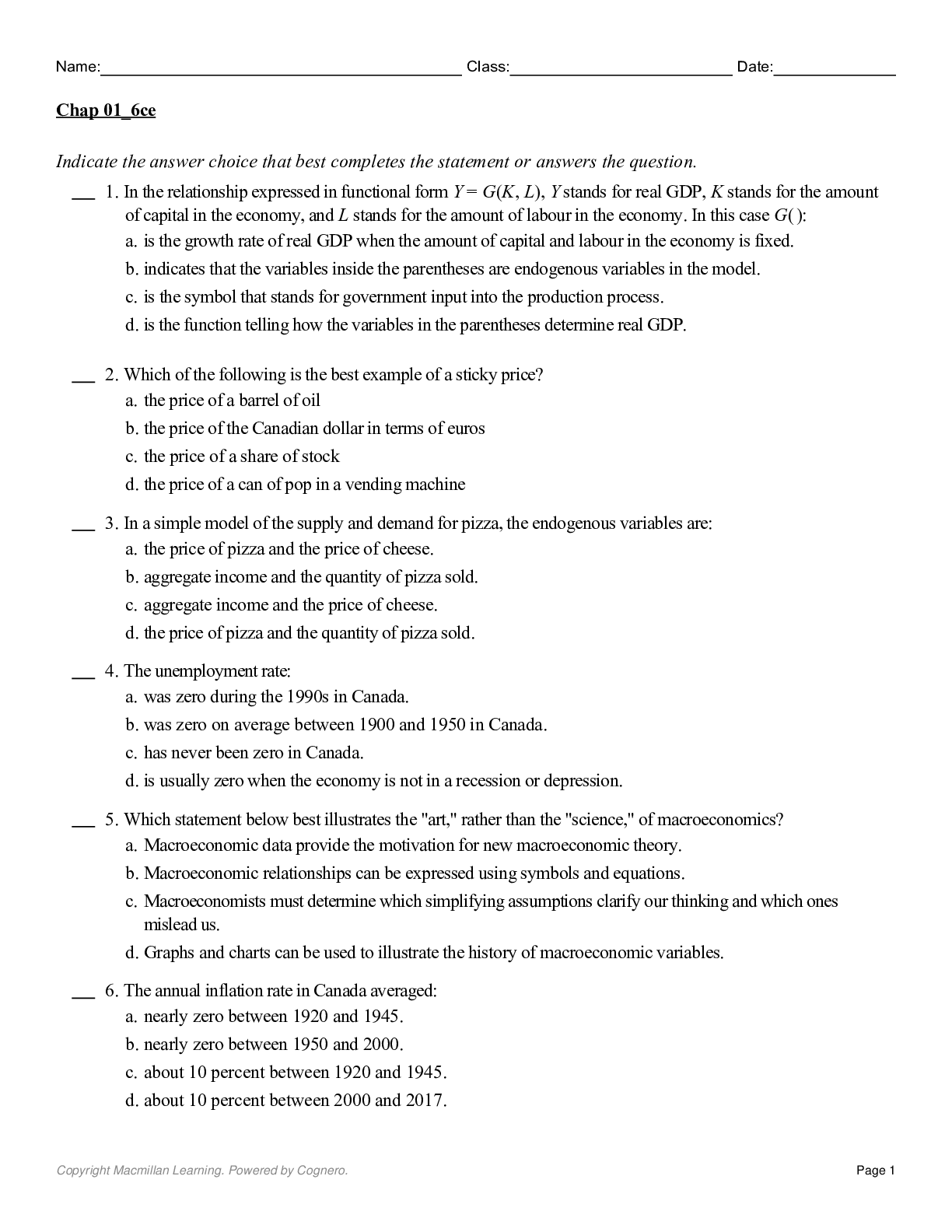
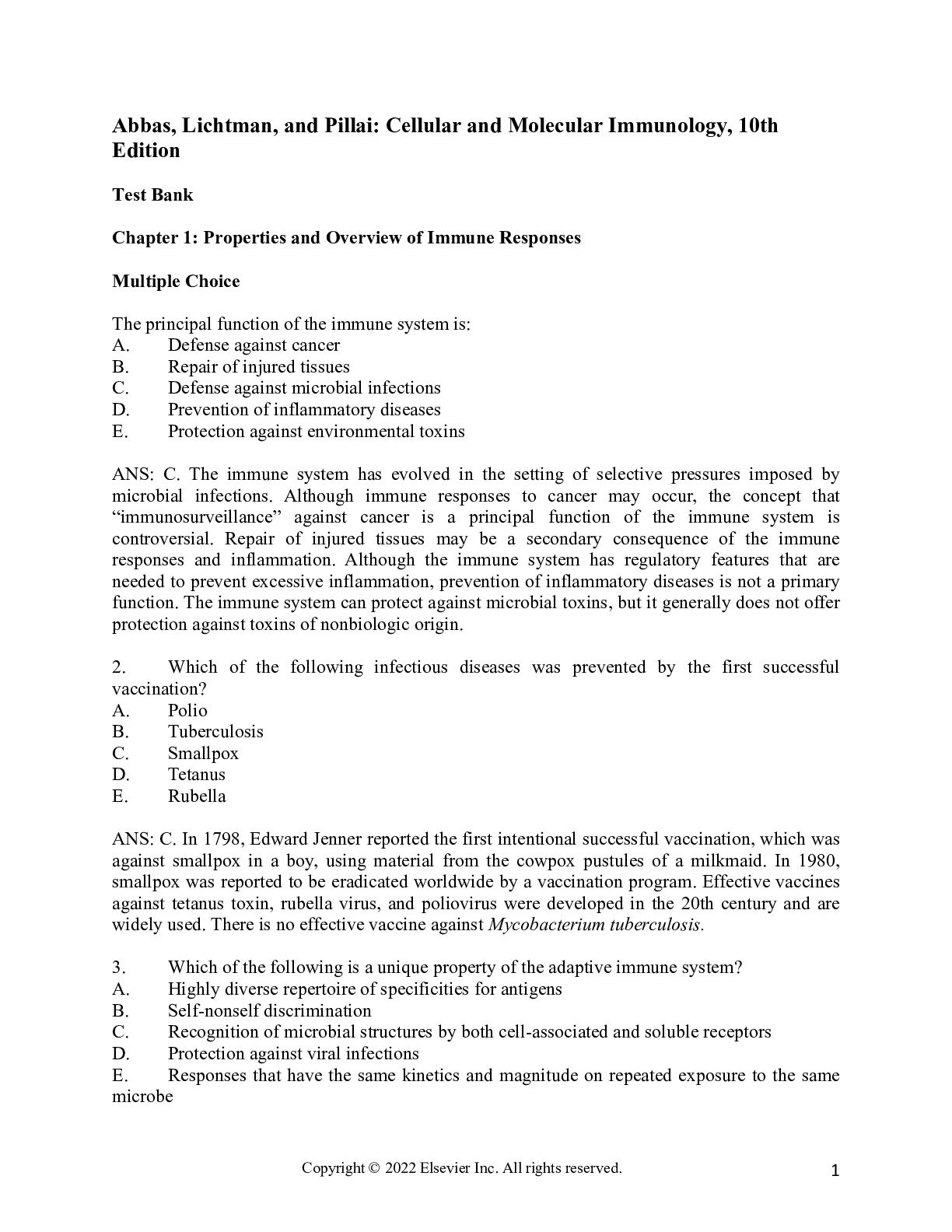

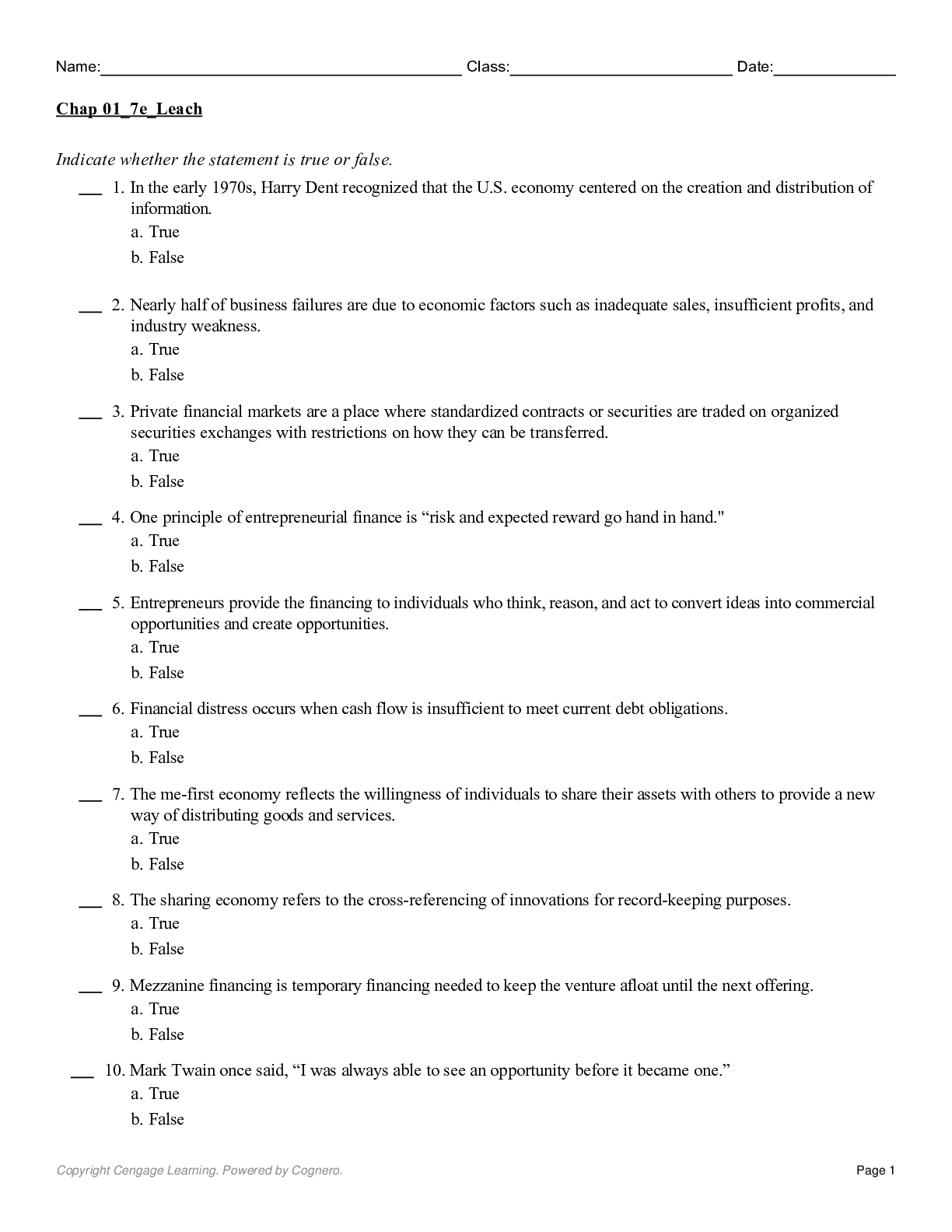
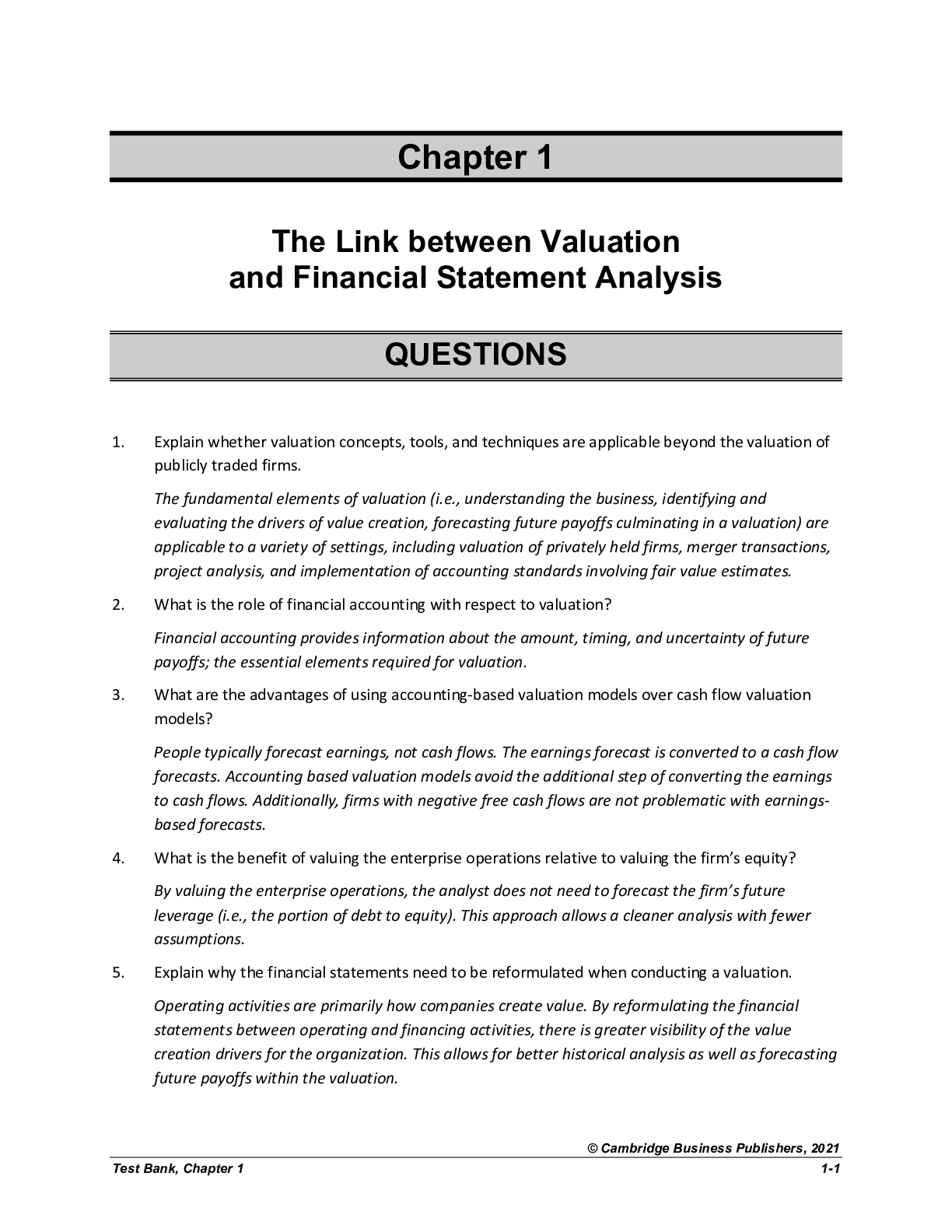
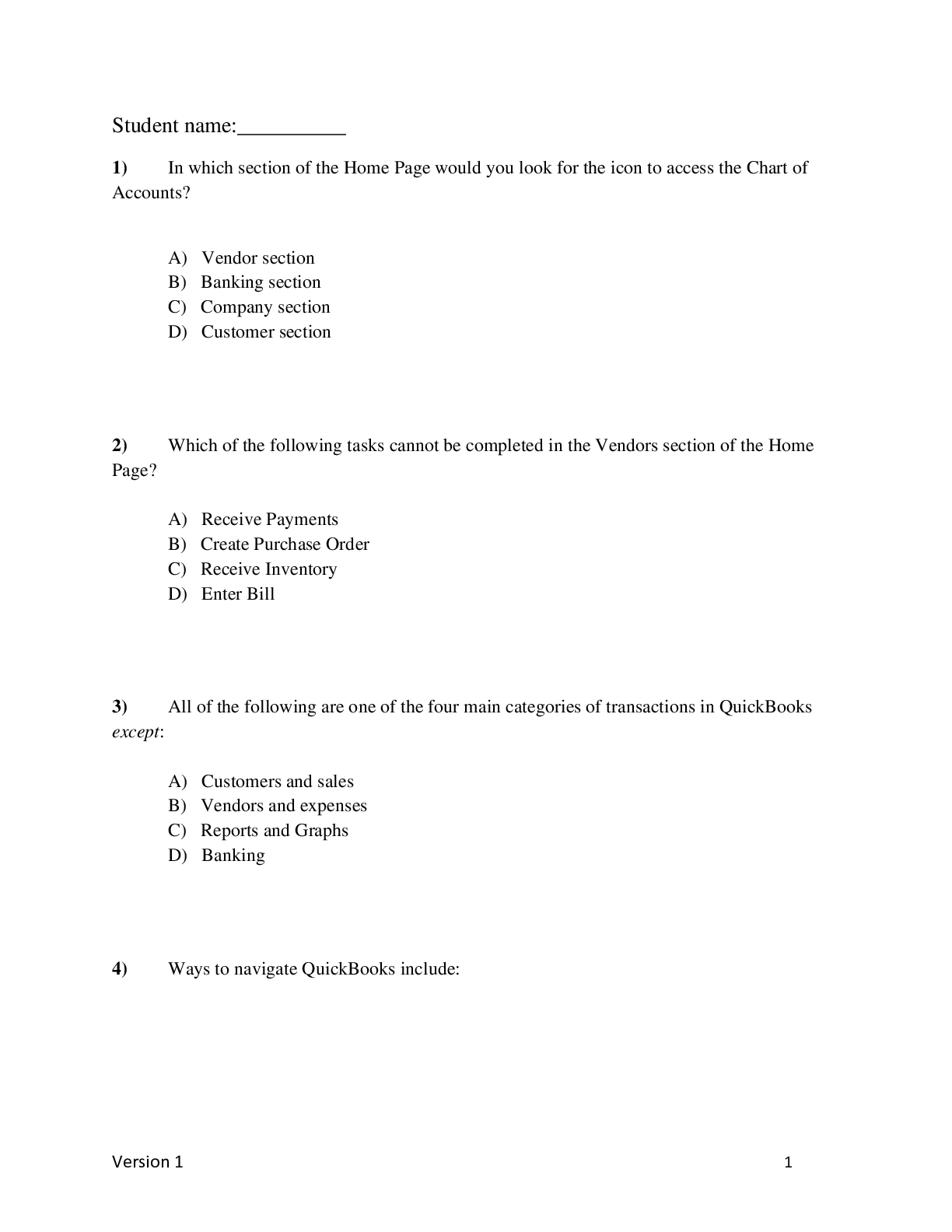
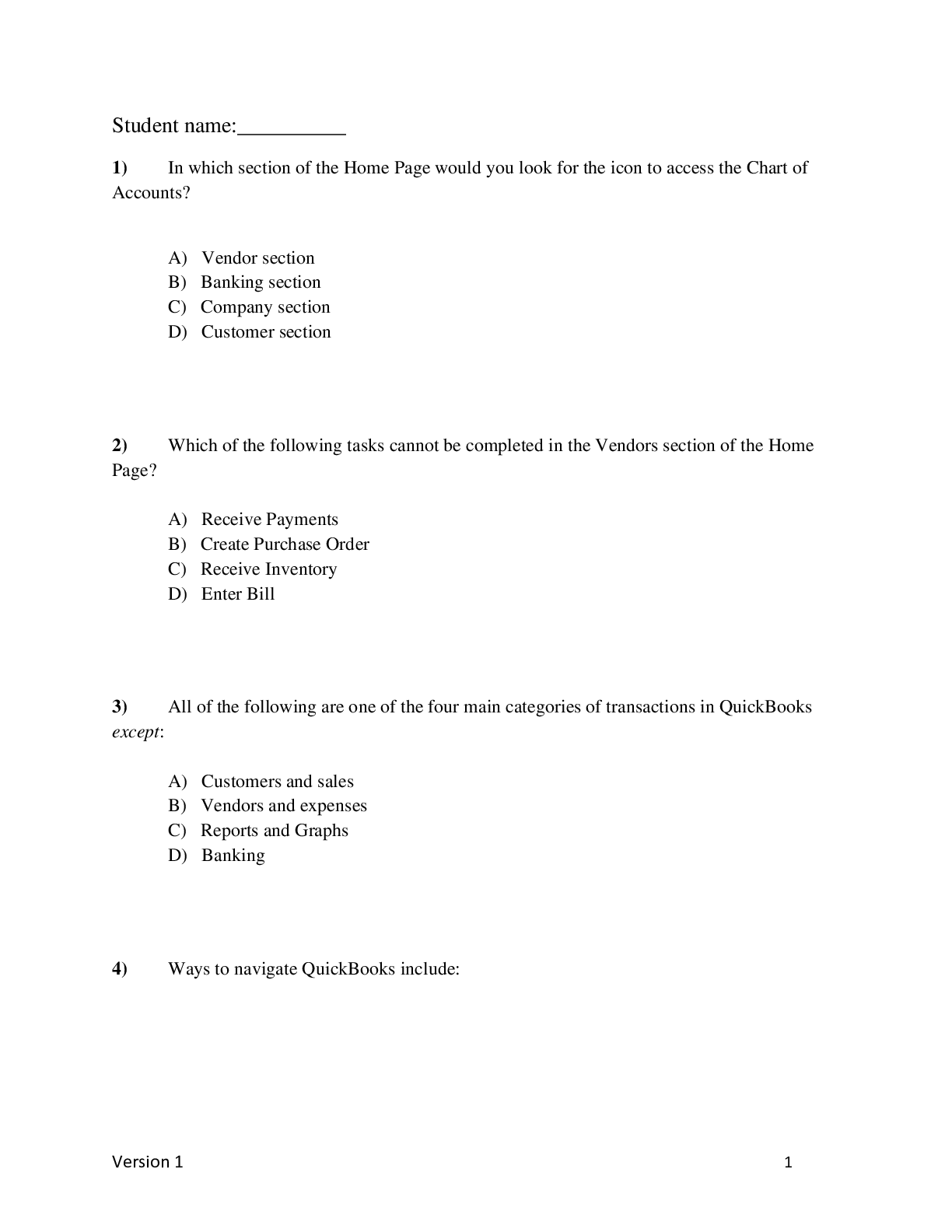
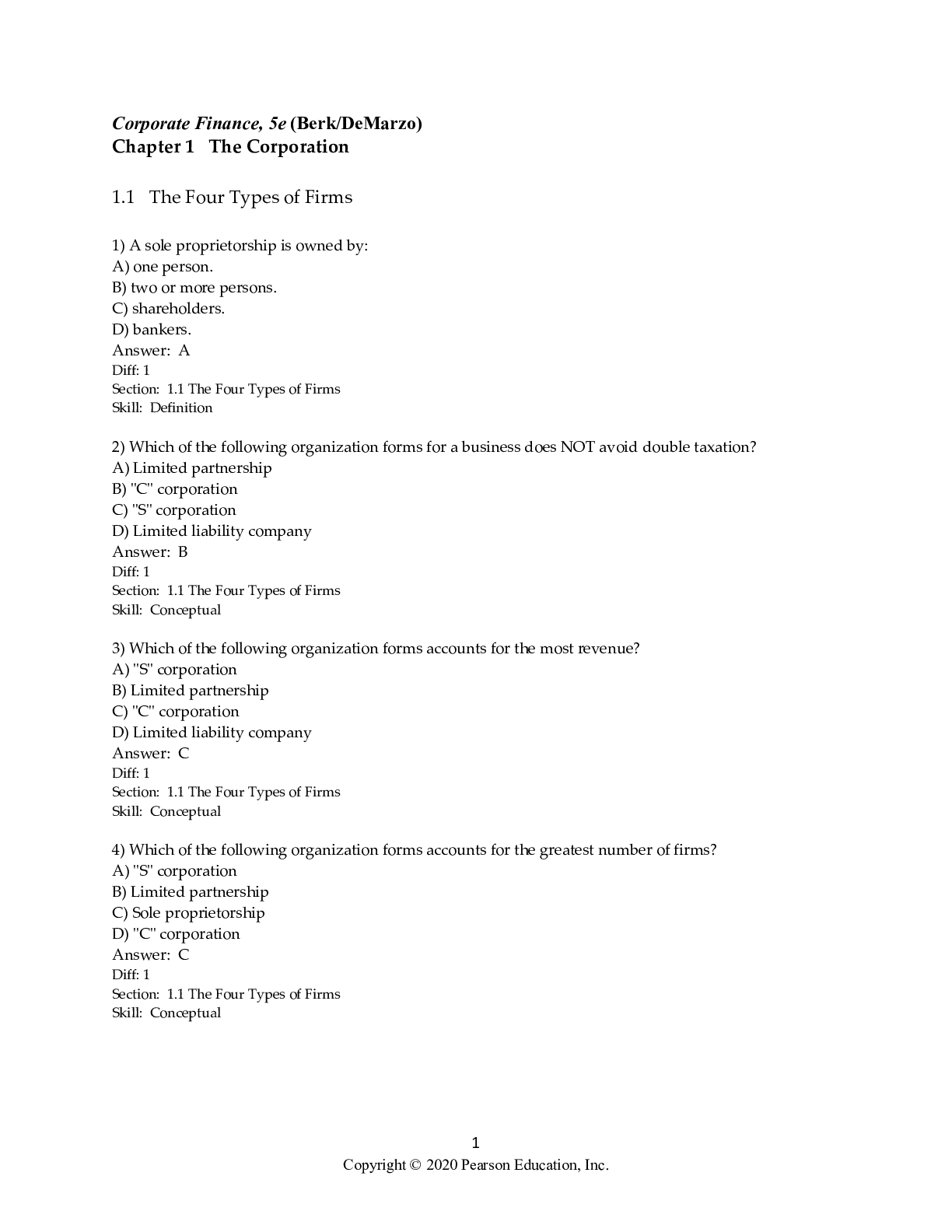
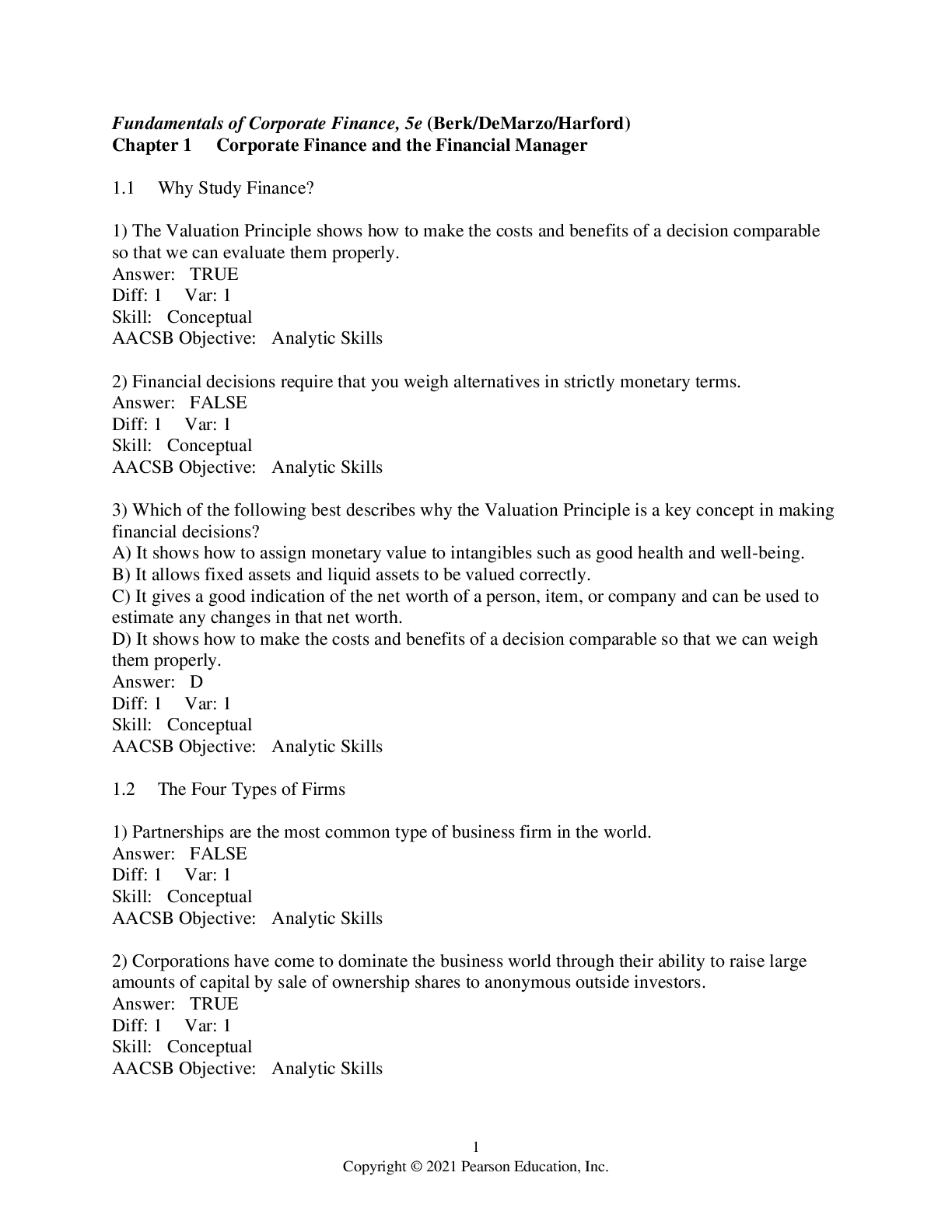
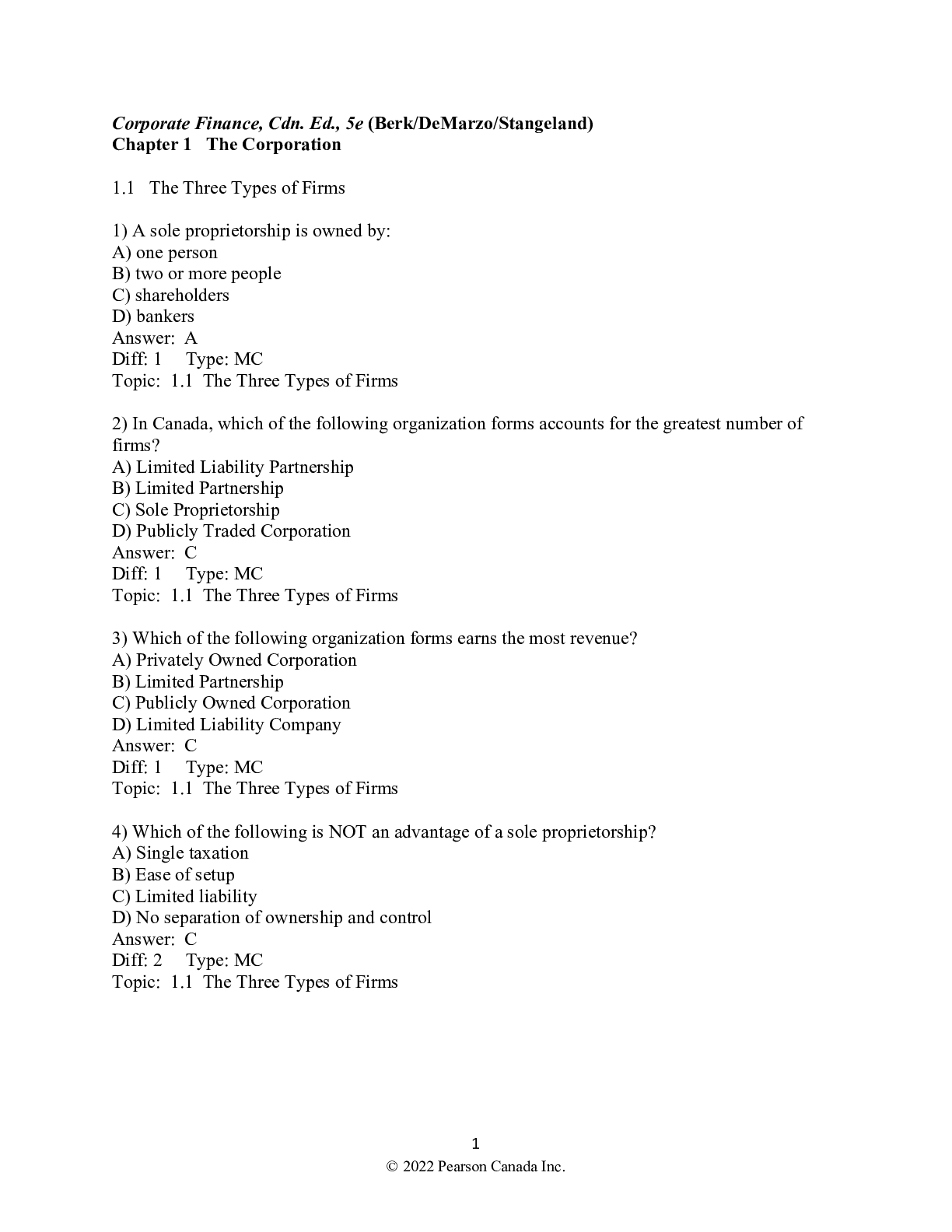
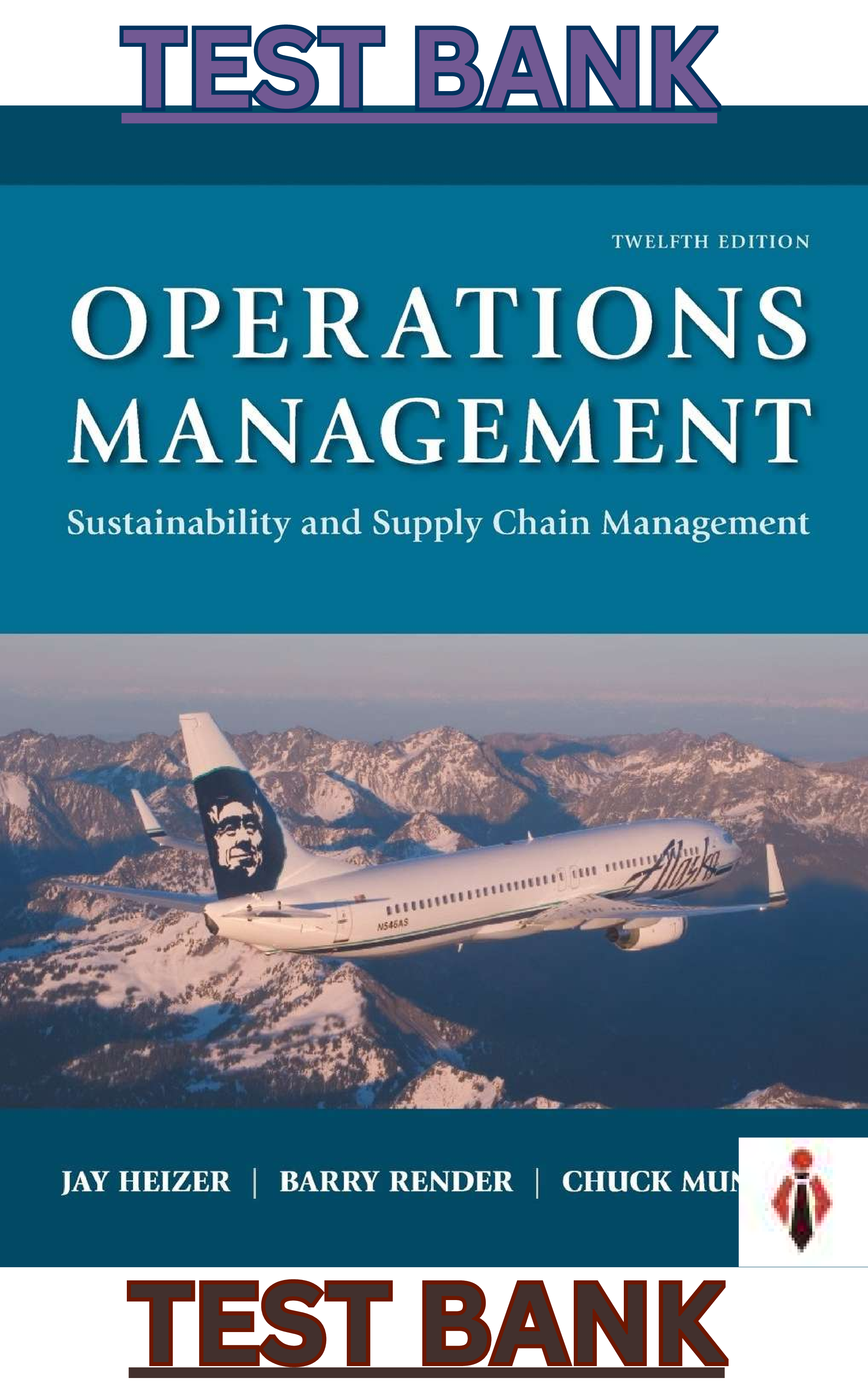
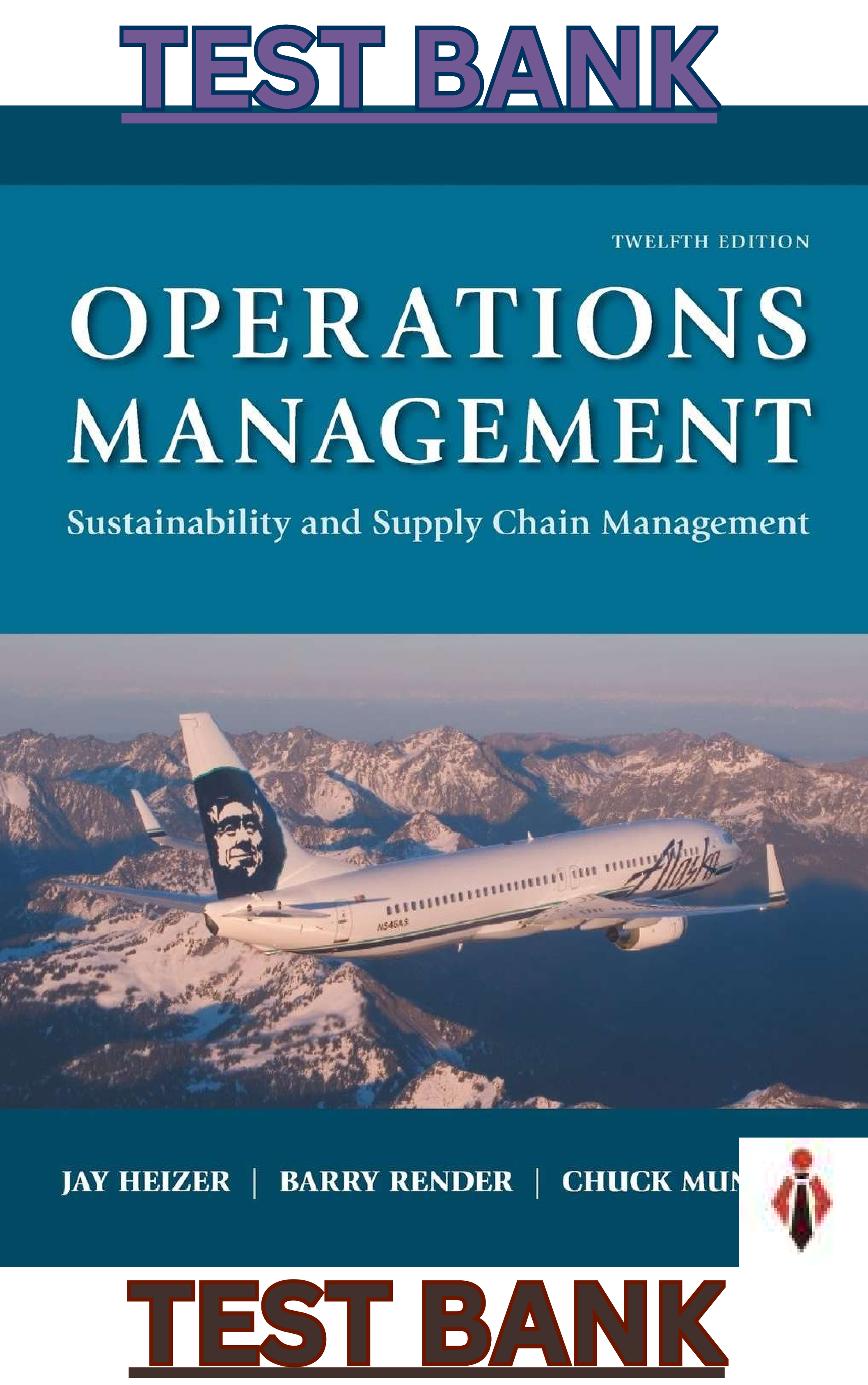
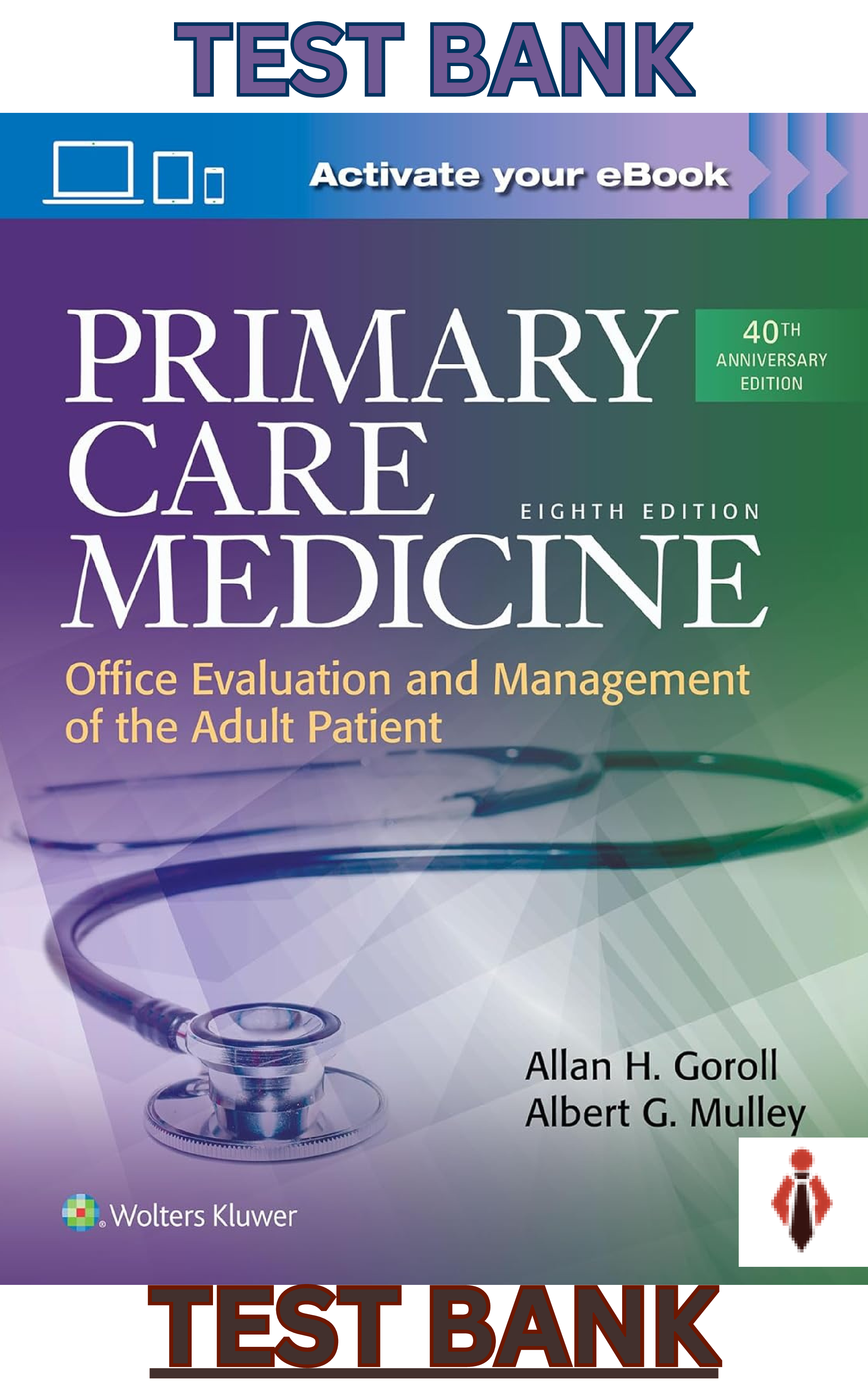

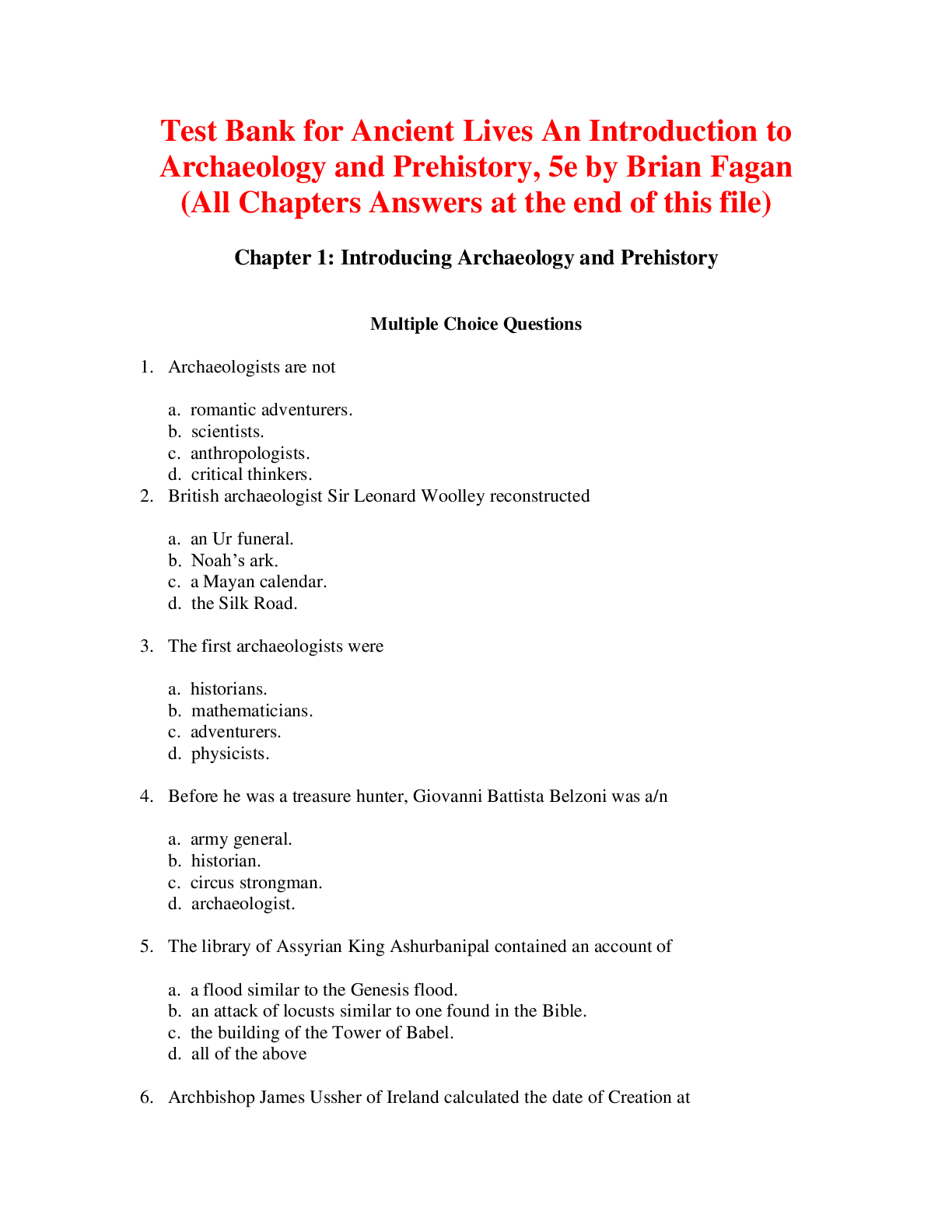
.png)
